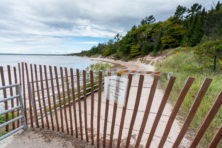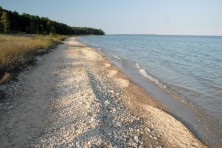Door County Beaches, Are We Ignoring the Signs?
- Share
- Tweet
- Pin
- Share

I want to believe them, want to remain ignorant, want to believe the water will come back. I want to, because the reality I’ll encounter if I think otherwise is frightening.
I drive through Ephraim at least twice every day from the house I rent in Sister Bay, and so, at least twice each day, I’m slapped in the face by the receding waters of Lake Michigan.
It first happened seven or eight years ago. The ice receded one spring, and to the astonishment of all who passed, the beach was significantly larger in Ephraim. That first year we were all talking about it, asking why, and we were happy and relieved to chalk it up to a normal ebb and flow of the great, unfathomable bodies of water that surround us.
Another spring came and the water had receded a little further. Shortly after the ice was gone we noticed vegetation taking over the shorelines – phragmites, grass, cladophora. Once again, it was easy to dismiss the changes and chalk it up to natural cycles of the lakes. Levels rise and fall periodically, and who are we to judge mother nature on a year-to-year, or even decade-to-decade scale? After all, the lake had been near all-time highs as recently as 1986 and 1997.
But then those beaches began to look unlike the beloved gateways to the water we had come to rely on to enhance our quality of life.
We saw our beaches overtaken by grass, most shorelines featuring a swath of green goo slapping at the shoreline, bordered by a thin strip of sand or rock, then a thick stripe of tall weeds and grass separating that strip from the old beach, a startling reminder of where the water used to meet the land.
In a few short years we’ve added dredging barges on the shore to the list of annual signs of spring. Cherry blossoms, the return of the birds, the influx of seasonal employees, and now, the arrival of the backhoes at the pier.
There are some startling correlations to the decline in tourism expenditures on the peninsula. The decline began in 2000, the first year after the closing of Thumb Fun. The cost of eating out on the peninsula rose, and the pace of condominium development quickened, and then 9/11 stunned the travel industry nationwide.
But there was another factor, one less cited. The drop in tourism dollars is also intertwined with the decline in the quality and attractiveness of our shoreline. Sand Bay was grass this summer. In Ephraim it appears a small child could wade across the bay if they wanted. Europe Bay is drastically different. In Sister Bay a kid jumping off the legendary swimming pier risks their ankles and neck.
With all due respect to the galleries, performing arts, restaurants, and shopping on the peninsula, we would be nothing as a destination without our beaches. They are our greatest asset, and the quality and attractiveness of them has declined precipitously over the past decade.
Today it seems every community on the peninsula is investigating a marina or shoreline project of some scale. These are multimillion-dollar projects that will be with us for generations, but I hear scarcely a word said about the future of Lake Michigan in these discussions. Nobody is looking a generation ahead. Everyone accepts it as gospel that the lake levels will rise again, but increasingly the evidence points to the contrary.
A recent report on CNN explored the travails of the entire Great Lakes region. Lake Superior and Huron are near record low levels. Superior’s average temperature has risen 4.5 degrees in the last 25 years, leaving less ice cover and leading to greater evaporation. One study predicts there will be no ice cover on Superior by 2040.
We’ve been diverting waters from the Great Lakes for a century to feed our manufacturing hubs. Approximately 2.5 billion gallons of water flows out of Lake Huron into the St. Clair River every day, much of it a result of a 1962 Army Corps of Engineers dredging project. Bottled water companies can mine our waters to no end, and now the water-starved states of the southwest are claiming rights to the lakes.
Many in the thirsty states of the middle and south west believe the Great Lakes are a national resource to be allocated to those in need, but one has to question the wisdom in depleting an asset as rare as the Great Lakes to make the arid land of Arizona, Nevada, and New Mexico artificially inhabitable.
So what if the levels don’t come back? What happens to these marina plans? How much dredging can we expect, and at what cost? Will boaters continue to clamor for slips here if our beaches continue to deteriorate, if the waters recede, if our shoreline smells?
It’s easy to dismiss these concerns. All you have to do is not watch TV, read the newspaper, log on to the Web, or listen to our local fishermen. The lakes are so large, so taken for granted as to seem unassailable. But we have warnings. Lake Mead. New Orleans. The Colorado River.
Or the most startling case, Kazakhstan’s Aral Sea, photos of which are so disconcerting on first viewing it’s easy to think they’re doctored. They could be the product of a savvy special effects team creating some environmental doomsday movie. It was the world’s fourth largest body of water in 1960. It now ranks ninth and covers a quarter of the surface area it did at its peak.
The Soviet Union engineered it to death, diverting the waters of the rivers that once fed it to feed an artificial cotton industry. Today Kazakhstan has a great cotton industry, but little remains of the Aral Sea. Fishing vessels sit rusting on sand. The Vozrozhdeniye Island is now part of the mainland. The sea is now split in four.
Work on a joint U.S. and Canadian study of the decline in Great Lakes water levels is progressing now, but conclusions are still years away and many doubt whether it will be comprehensive enough to pinpoint the problems.
It would behoove us on the peninsula to pay close attention as we continue to invest in shoreline development and bet our future on it. When you look into environmental catastrophes, you learn that most often, tragedies aren’t exactly gradual. There’s a slow decline, followed by a sudden and precipitous fall that appears to come out of nowhere. It would be sad to be part of a generation that let catastrophe sneak up on us because we ignored the signs.
The myriad changes we’re witnessing in our lakes might be natural, part of a normal cycle. What a relief it would be if they are. But our engineering might have something to do with it, and judging by our track record, I’m prone to lean toward this latter conclusion. And if that’s the case, then we owe our environment and ourselves something better than ignorant bliss and guesses.
To investigate further, check out the reporting of Dan Egan in the Milwaukee Journal Sentinal at http://www.jsonline.com/story/index.aspx?id=659188. To view the CNN report on the Great Lakes visit CNN.com and search for Great Lakes under CNN Videos.



